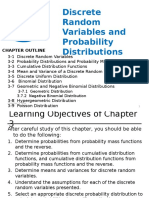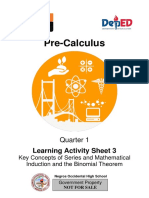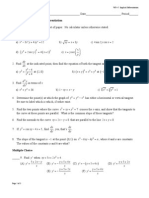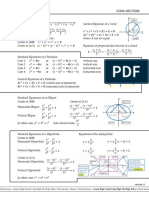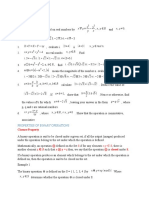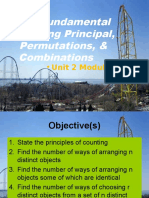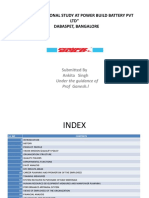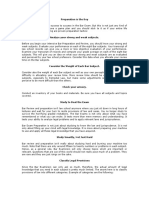100%(3)100% found this document useful (3 votes)
2K viewsBasic Probability
Basic Probability
Uploaded by
hellobebeThe document provides an introduction to probability and statistics. It defines key terms like probability, statistical inference, experiments, sample space, events, and operations on events. It also covers counting principles like the multiplication rule and addition rule. The document gives examples of how to calculate the number of possible outcomes for random experiments using these fundamental probability concepts.
Copyright:
Attribution Non-Commercial (BY-NC)
Available Formats
Download as PDF, TXT or read online from Scribd
Basic Probability
Basic Probability
Uploaded by
hellobebe100%(3)100% found this document useful (3 votes)
2K views12 pagesThe document provides an introduction to probability and statistics. It defines key terms like probability, statistical inference, experiments, sample space, events, and operations on events. It also covers counting principles like the multiplication rule and addition rule. The document gives examples of how to calculate the number of possible outcomes for random experiments using these fundamental probability concepts.
Original Description:
Introduction to basic probability concepts.
Copyright
© Attribution Non-Commercial (BY-NC)
Available Formats
PDF, TXT or read online from Scribd
Share this document
Did you find this document useful?
Is this content inappropriate?
The document provides an introduction to probability and statistics. It defines key terms like probability, statistical inference, experiments, sample space, events, and operations on events. It also covers counting principles like the multiplication rule and addition rule. The document gives examples of how to calculate the number of possible outcomes for random experiments using these fundamental probability concepts.
Copyright:
Attribution Non-Commercial (BY-NC)
Available Formats
Download as PDF, TXT or read online from Scribd
Download as pdf or txt
100%(3)100% found this document useful (3 votes)
2K views12 pagesBasic Probability
Basic Probability
Uploaded by
hellobebeThe document provides an introduction to probability and statistics. It defines key terms like probability, statistical inference, experiments, sample space, events, and operations on events. It also covers counting principles like the multiplication rule and addition rule. The document gives examples of how to calculate the number of possible outcomes for random experiments using these fundamental probability concepts.
Copyright:
Attribution Non-Commercial (BY-NC)
Available Formats
Download as PDF, TXT or read online from Scribd
Download as pdf or txt
You are on page 1of 12
QUAMETH Notes: Introduction to Probability Page 1 of 12
INTRODUCTION TO PROBABILITY AND STATISTICS
Probability - an index which measures the chance or likelihood that an event resulting
from a statistical experiment will occur.
Statistical Inference - process of using sample information to draw conclusions about
certain characteristics of a population that is under study.
Importance:
The study of probability and statistical inference aids in the translation of sample
information into something conclusive or inconclusive about the scientific system under
study. It allows us to quantify the strength or confidence that we have in our
conclusions. More importantly, the conclusion drawn about the scientific system being
studied helps an individual in the decision-making process.
Experiment - a process which generates an observation or a measurement commonly
referred to as raw data or information
An experiment is considered to be a random or chance process if:
1. all possible outcomes are known before the experiment is performed
2. no particular outcome can be predicted with certainty before the performance of the
trial or experiment
* Classical examples include the rolling of a die and the tossing of a coin.
Sample Space (S) - a list of all possible outcomes of an experiment defined in such a
way that exactly one of the elements will occur
Sample Point (x) - refers to each possible outcome or element in the sample space
Three Ways of Defining a Sample Space:
1. Listing/Roster Method - done by enumerating all the elements of the sample space
2. Defining Property Method - done by choosing a property or characteristic common to
all sample points and then using this common characteristic to define the sample
space
3. Tree Diagram - uses a tree to express the sequence of events of an experiment in
chronological order.
Note: The way by which the sample space is defined is not unique for an experiment. It
depends on how an individual defines the sample points of the experiment.
Examples:
1. Define the sample space of the following experiments:
a. Toss a coin two times
b. Toss a coin, roll a die, then toss a coin
c. A product comes out of a production line either as defective or non defective.
Two products are inspected, one at a time.
QUAMETH Notes: Introduction to Probability Page 2 of 12
2. Two ordinary dice are tossed and we define the sample points (denoted by x) to be the
sum of the numbers turning up. Use the defining property method to define the
sample space. Define the sample space if sample points are defined as the difference
between the numbers turning up
Event - subset of a sample space
Simple Event - an event which consists of only one outcome
Compound Event - an event which consists of more than one outcome and may be
decomposed into simple events
Example:
Roll a die and observe the number appearing on the upper face. The following are some
of the possible events:
A - event that an odd number appears E - a 3 appears
B - event that an even number appears F - a 4 appears
C - a 1 appears G - a 5 appears
D - a 2 appears H - a 6 appears
Events A & B are known as compound events while events C to H are simple events.
Operations with Events
1. A U B - the set whose elements belong to A or B or both; referred to as the union
between events A and B
- includes the possibility that only event A will happen or only event B will
happen, or both A and B will happen at the same time
Terms used to imply union of events:
- either event A or event B will occur
- one or the other will occur
- at least one of the two events will occur
- one of the two events will occur
- a/an event will occur
2. A B - set whose members are elements of both A and B; referred to as the
intersection between A & B
- means that both events will happen at the same time
Terms used to imply intersection of events:
- both A and B will happen
- neither event A nor B will happen (intersection of the complements)
Note: If two events cannot happen at the same time, then they are said to be mutually
exclusive events or disjoint events.
3. The complement of A, A, is the set of all elements not found in A. A represents the
event that A will not happen.
QUAMETH Notes: Introduction to Probability Page 3 of 12
4. If we let S be the sample space, then the complement of S (S) is known as the
impossible event/empty set/null set.
S = |; | u S = S
To be discussed in class:
Venn Diagram representations of the union bet. 2 events, intersection bet. 2 events,
mutually exclusive events, and the complement of an event
Counting Theory - a set of techniques used for identifying the total number of
possibilities of a statistical experiment without enumerating the elements
of the sample space
Multiplication Rule - If an experiment can be performed in n
1
ways on trial 1, and for
each of these n
1
ways, it can be performed in n
2
ways on trial 2, and
for each of these n
2
ways, it can be performed in n
3
ways on trial 3
and so on for k trials,
then the total number of ways (n
T
) by which
we can perform the entire experiment is:
n
T
= n
1
x n
2
x n
3
x ...... x n
k
Addition Rule - If k outcomes are mutually exclusive, and outcome 1 can be performed
in m
1
ways, outcome 2 can be performed in m
2
ways, and so on for k
outcomes, then the total number of outcomes is given by:
m
T
= m
1
+ m
2
+ ...... + m
k
Examples:
1. Five chips numbered 1 to 5 are in a container. You are asked to get 3 chips from the
container, one at a time. In how many ways can this experiment be performed or how
many possible outcomes are there if sampling is done without replacement? with
replacement?
2. Consider the same problem as in # 1 above but this time, you are to get only one chip
from the container. If the number on the chip is even, you have to roll a die. On the
other hand, if the number on the chip is odd, you have to toss a coin. How many
possible outcomes are there in this experiment?
3. Three boys and three girls are to sit in 6 chairs arranged in a straight line. How many
seating arrangements are possible if:
a. there are no constraints?
b. two girls quarrelling over one guy refuse to sit beside each other?
c. if boys and girls are to alternate?
d. The 3 boys and 3 girls actually form 3 couples. How many seating arrangements
are possible if couples should sit beside each other?
e. How many arrangements are possible if 3 people prefer to be seated together?
QUAMETH Notes: Introduction to Probability Page 4 of 12
4. Given the numbers 0,1,2,3,4,5,6,7,8,9
a. How many 3 digit numbers can be formed without repetition?
b. How many of these 3 digit numbers are even? How many are odd?
c. How many of these numbers are greater than 342?
d. How many of the numbers greater than 342 are even?
e. How many 3 digit numbers can be formed with repetition?
Simple Permutation - an ordered arrangement of distinct objects
Symbol:
n
P
r
where n = the total number of distinct objects to be arranged
r = number of objects to be taken from n
Formula: n!
nPr = --------
(n-r)!
Example:
In how many ways can you arrange the 5 letters A, B, C, D and E if you take:
a. 2 letters at a time?
b. 3 letters at a time?
c. 4 letters at a time?
d. all letters at the same time?
Simple Combination - an arrangement of distinct objects without regard to order
Symbol:
n
C
r
Formula: n!
n
C
r
= -----------
r! (n-r)!
Example:
Consider 3 letters A, B and C. How many combinations of 2 letters are possible?
Special Types of Permutations
A. Circular Permutation - arrangement of objects in a circle
Technique: In order to arrange objects in a circle, it is important to have a reference
point. This is done by fixing one of the objects.
Symbol: P
nc
read as permutation of n objects in a circle
Formula: P
nc
= (n-1)!
QUAMETH Notes: Introduction to Probability Page 5 of 12
Examples:
1. In how many ways can we arrange four boys in a round table?
Ans.: (4-1)! = 6 ways
2. In how many ways can we arrange 3 boys and 3 girls in a circular table if:
a. 2 boys hate each other and would not want to sit beside each other? Ans.: 72
b. boys and girls are to alternate? Ans.: 12
c. the 3 boys and 3 girls form 3 couples and they are to sit beside each other?Ans.:16
Note: Answers to a, b and c will be discussed in class
B. Arrangement of Similar Objects
Objective: To find the number of permutations of n objects all taken at the same time;
n
1
of which are of type 1, n
2
of which are of type 2, ..., n
k
of which are of type k, where:
k
n
i
= n
i=1
Formula: | n | = n!
\ n
1
, n
2
, ..., n
k
. ---------------------
n
1
! n
2
! ...... n
k
!
Examples:
1. In how many ways can we arrange 5 objects, 3 of which are A and 2 are B?
In this problem, we have n=5; n
1
=3 and n
2
=2
Enumerating the total number of ways, we have the following:
AAABB BABAA
ABABA BBAAA 5!
AABAB BAAAB Ans. = 10 ways or ---------- = 10 ways
AABBA BAABA 3! 2!
ABBAA ABAAB
2. Given a true-false exam, if you know that 6 of the items have true as answer and 4
have false as answer, in how many ways could you answer the exam?
10!
Ans. = ---------- = 210 ways
6! 4!
C. Partitioning of n objects into cells
Objective: To find the number of permutations of n objects all taken at the same time;
n
1
of which are to be placed in cell 1, n
2
of which are to be placed in cell 2, ..., n
k
of
which are to be placed in cell k where:
k
n
i
= n
i=1
Formula: | n | = n!
\ n
1
, n
2
, ..., n
k
. ---------------------
n
1
! n
2
! ...... n
k
!
QUAMETH Notes: Introduction to Probability Page 6 of 12
Example:
In how many ways can 4 people occupy 2 rooms if 2 people are to occupy each
room?
4!
Ans. = ------- = 6 ways
2! 2!
What if there are no constraints?
Room 1 Room 2
Case 1: 1 3 4!/1!3! = 4 ways
Case 2: 2 2 4!/2!2! = 6 ways
Case 3: 3 1 4!/3!1! = 4 ways
Ans. = 14 ways
Probability - an index which measures the likelihood or chance that an event resulting
from a statistical experiment will occur
Let: A - a particular event in the sample space
P(A) or P
A
- probability that event A will occur
Axiom 1: 0 s P
A
s 1
Axiom 2: P
A
= 1 is the certain event or the probability of the entire sample space.
Axiom 3: P
A
= 0 is the improbable event.
Axiom 4: If the probabilities of events in the sample space are added, the result should
be unity.
n
P (E
i
) = 1
i=1
Ways of Measuring Probability
1. Classical Concept - the probabilities of events can be known even w/o data gathering
- used in classical experiments such as the rolling of a die or the
tossing of a coin
n(A) where:
P(A) = -------- n(A) - subset of the sample space pertaining to event A
N N - total sample space
Example:
A coin is tossed 5 times. What is the probability that:
a. exactly 3 heads will occur?
b. at least 2 heads will occur?
QUAMETH Notes: Introduction to Probability Page 7 of 12
2. Relative Frequency - makes use of historical data or survey results to determine
probabilities
f
A
where:
P(A) = ------- f
A
- frequency of occurrence of A
f
T
f
T
- total number of observations
3. Subjective Assessment - an expert in the field gives an educated guess of the
probability
Probability Rules
1. P(AUB) = P(A) + P(B) - P(AB)
- probability that at least one of the 2 events will occur
(A only, B only, both A & B)
P(AB) - probability that both A and B will happen at the same time
P(A) - includes the possibility that event B will happen
P(B) - includes the possibility that event A will happen
From the above definition of P(AUB), it follows that:
P(AUBUC) = P(A) + P(B) - P(AB) + P(C) - P(AC) - P(BC) + P(ABC)
2. P(AUB) = P(A) + P(B) if A and B are mutually exclusive events
It follows that: P(A
1
UA
2
UA
3
U ... A
k
) = P(A
1
) + P(A
2
) + P(A
3
) + ... + P(A
k
)
if all events are mutually exclusive
3. P(A) = 1 - P(A)
- probability that event A will not happen
From the Venn Diagram, the probability of the entire sample space can actually be
expressed as:
P(Sample Space) = P(AB) + P(AB) + P(AB) + P(AB)
Contingency Table - a tool used to facilitate the calculation of probabilities involving
two events
B B Total
----------------------------------------------------------
A P(AB) P(AB) P(A)
A P(AB) P(AB) P(A)
----------------------------------------------------------
Total P(B) P(B) 1
Example:
In an office, there are 2 secretaries. The probability that secretary 1 is present in any
given day is 92% while the probability that secretary 2 is present in any given day is
QUAMETH Notes: Introduction to Probability Page 8 of 12
98%. The probability that both will be present in a given day is 91%. In a given day,
what is the probability that:
a. either secretary 1 or secretary 2 is present
b. neither secretary 1 nor secretary 2 is present
c. only secretary 1 is present
d. a secretary is not available to do a job
e. exactly one secretary is absent
Conditional Probability - probability that an event will occur given that some other
event has already occurred
- serves to limit or reduce the sample space
Symbol: P(A/B) read as probability of A given B
Formula: P(AB)
P(A/B) = --------------
P(B)
Example:
Roll a die twice.
a. What is the probability of getting a 4?
b. What is the probability of getting a 4 given that the other die shows a 5?
Multiplication Law of Probability
From the conditional probability formula:
P(AB)
P(A/B) = -------------- P(AB) = P(B) * P(A/B)
P(B)
P(AB)
P(B/A) = -------------- P(AB) = P(A) * P(B/A)
P(A)
P(AB) = P(A) * P(B) if 2 events are independent of each other, meaning, the
probability of occurrence of event B is not affected by the probability of occurrence of
event A and vice-versa.
Bayes Theorem
Instead of being concerned with deducing the consequences arising from a given
hypothesis, Reverend Thomas Bayes concentrated on making hypotheses from the
observation of the consequences. Normally, we are always interested in finding the
P(effect/cause). Bayes theorem, on the other hand, tries to find the P(cause/effect).
QUAMETH Notes: Introduction to Probability Page 9 of 12
Example:
There are 3 bins containing red and green pens. Bin 1 contains 4 red pens and 2 green
pens. Bin 2 has 2 red pens and 3 green pens while bin 3 has 6 red pens and 1 green pen.
A red pen was obtained. What is the probability that the red pen obtained was from bin
2? Tool: Use Tree Diagram
Problem Set
1. An experiment consists of rolling a die and then flipping a coin if the number on the
uppermost face of the die is even. If the number is odd, the experiment is stopped.
List the elements of the sample space S.
2. Given: S = ( A, B, C, D, E, F, G, H, I, J) A = (A, C, E, G, I)
B = (B, D, F, H, J) C = (A, B, E, F)
D = (B, H, I, J)
Find:
a. A U D b. A B c. D d. (C U D) A e. (A U D) f. A C D
3. A service company presently uses 2-ply rated tires and averages 20,000 miles per tire.
XYZ Company sends the service firm two tires to test. Let 0 represent the event that
a tire lasted 20,000 miles or less and 1 represent the event that a tire lasted more
than 20,000 miles. We define four elementary events as:
A = (0, 0) B = (1, 0) C = (0, 1) D = (1, 1)
and the sample space as S = {(0, 0), (1, 0), (0, 1), (1, 1)}
The first digit in each element represents the outcome for the first tire and the second
digit represents the outcome for the second tire.
Express the following statements verbally:
a. B U C U D b. (A D) c. A U D d. B U C
e. A U D f. A U D g. A D h. A U D
4. A committee consists of 10 people. It is decided to appoint a chairman, a vice-
chairman and a secretary-treasurer. In how many different ways can this be done?
5. A committee consists of five union and four non-union men. In how many ways can
a subcommittee of six be formed a.) consisting of four union and two non-union men?
b.) consisting of at least three union members?
6. In a determination of preference of package design, a panel of housewives was given
seven different designs and asked to rate them. How many possible rankings could
the panel have given (excluding ties)?
7. An instructor has written 20 problems. Five of these are so important that she assigns
them to every student. In addition, each student is assigned five other problems. In
how many ways can she assign problems to a student?
QUAMETH Notes: Introduction to Probability Page 10 of 12
8. There are 12 men under consideration for the 5-man Board of Directors of the newly
formed Crunch Candy Corporation. Three of these men are known to be sworn
mutual enemies and if any one of them is on the board, the other two must not be.
a. In how many ways can the Board of Directors be chosen?
b. After its selection, the Board of Directors will elect from its membership a
president and a vice-president, how many possible outcomes are there for such an
election?
9. Staggering into his clubs cloakroom after a hard evening, Tit saw 6 hats on the shelf.
A little later, Tat came into the cloakroom and took a hat that he thought was his. The
next day, each man discovered that he had someone elses hat. In how many ways
could both Tit and Tat have gotten the wrong hats?
10. Six people are going on a picnic in two cars that will hold 5 and 4 passengers
respectively. How many ways is it possible to transport the six people to the picnic
grounds?
11. A group of 5 boys took their girlfriends with them to a seaside picnic right after their
quiz in QUAMETH.
a. They arrived at the resort late in the afternoon and decided to rent a large cottage
having three rooms with the following maximum allowable number of occupants
per room: 5 persons in the Royal Suite; 4 persons in the De Luxe Suite; and 3
persons in the Standard Suite. Following their parents strict advice, the girls did
not sleep in the same room where the boys did. How many possible ways can the
vacationists sleep for the night?
b. The following morning, they went to the kitchen hall and gathered around a
circular table to eat their breakfast. How many ways can they sit around the table
if the couples are to be sitting together?
c. They formed a committee of four persons to prepare lunch. One of the
vacationists was a good cook and it was decided that she should be on the
committee. Two other girls, however, who are always quarreling, should not be
on the committee both at the same time. How many possible committees are
there?
d. Late in the afternoon, to liven up their merienda, they decided to put up a contest.
They have 1
st
, 2
nd
and 3
rd
prizes at stake. How many ways can these prizes be
won?
e. They had to leave before dark so they started to pack up their things. To bid each
other farewell, they shook hands with each other. Of course, the boys did not
shook hands with their own girlfriends; instead they kissed them goodbye. How
many handshakes were there assuming that two persons shook hands with each
other only once?
12. The Slaughter Meat Company has 60 employees. Fifteen are member of the United
Slicers Union, 35 are members of the Brotherhood of Slicers and the remainder are
non-union. In the past week, one member from each union and three non-union men
worked overtime. What is the probability of this particular selection?
QUAMETH Notes: Introduction to Probability Page 11 of 12
13. A box of ten items contains 7 good and 3 defective items. If a sample of two items is
selected, what is the probability that:
a. Both will be good?
b. Both will be defective?
c. At least one will be good?
14. The probability that machine A will break down on a particular day is P(A) = 1/50;
similarly, for machine B, P(B) = 1/100. Assuming independence, on a particular day,
a. What is the probability that both will break down?
b. What is the probability that at most one will break down?
c. What is the probability that neither will break down?
d. What is the probability that one or the other will break down?
e. What is the probability that exactly one will break down?
15. The Guessight Employee Agency administers a Verbal Comprehension test and a
Verbal Reasoning test to each of its applicants. On the Verbal Comprehension test, a
score of above 14 is considered passing and on the Verbal Reasoning test, a score of
19 is considered passing. From the agencys records, it has been determined that 10%
of the applicants fail the Verbal Comprehension test, 12% fail the verbal reasoning
test and 20% fail at least one of the tests.
a. What is the probability that a randomly selected applicant passes both tests?
b. What is the probability that an applicant will fail in only one of the tests?
c. If an applicant randomly selected passed the Verbal Reasoning test, what is the
probability that he also passed the Verbal Comprehension test?
16. A candidate runs for two political offices, A and B. He assigns 0.30 as the
probability of being elected to both, 0.6 as the probability of being elected to A if he
is elected to B and 0.8 as the probability of being elected to B if he is elected to A.
a. What is the probability of being elected to A?
b. What is the probability of being elected to B?
c. What is the probability of being elected to neither?
d. What is the probability of being elected to at least one of the offices?
e. What is the probability of being elected to exactly one office?
17. Graduation exercises are to be held outdoors on Thursday if it does not rain. If it
rains on Thursday, the exercises will be postponed until Friday and held outdoors if it
does not rain and indoors if it rains. The probability that it would rain on Thursday is
0.4 and the probability it will not rain on Friday if it rains on Thursday is 0.6. Find
the probability that the exercises will be held outdoors.
18. Job candidates are screened by means of preliminary interview. The probability is
0.7 that a screened candidate will be a good worker. Screened candidates are given a
test. If the candidate is one who will prove to be a good worker, the probability of his
passing the test is 0.8. If the candidate is one who will prove to be a poor worker, the
probability of his passing the test is 0.3.
QUAMETH Notes: Introduction to Probability Page 12 of 12
a. What is the probability that a screened candidate will be a good worker and pass
the test?
b. What is the probability that a screened candidate will not be a good worker and
will pass the test?
19. A lathe operator needs a certain size fitting to complete a job, but he does not know
its stock number. There are 15 fittings in the stock room of which 8 are the correct
size. The lathe operator orders 5 fittings to be picked at random from the stock room.
a. What is the probability that at least one of the five will be the correct size?
b. What is the probability that exactly two are of the correct size?
20. An ordinary die is tossed once. If a 1 appears, a ball is drawn from Urn 1. If a 2, 3 or
4 appears, a ball is drawn from Urn 2; otherwise, a ball is drawn from Urn 3. Urn 1
contains 5 white, 3 green and 2 red balls. Urn 2 contains 1 white, 6 green and 3 red
balls. Urn 3 contains 3 white, 1 green and 6 red balls.
a. What is the probability that a red ball is drawn?
b. What is the probability that Urn 2 is selected if a red ball is drawn?
21. The Wash White Company has 3 machines (A, B and C) that produces the same part.
Machine A produces 60% of the total volume and produces 80% acceptable parts and
20% rejects. Machine B and C each produce 20% of the total volume. Machine B
produces 60% acceptable parts and 40% rejects. Machine C produces 50%
acceptable parts and 50% rejects. Three elements were sampled from a production lot
and all were found to be acceptable. What is the probability that the samples were
produced by Machine A?
22. The probability that an airplane accident which is due to structural failure is
diagnosed correctly is 0.9 and the probability that an airplane accident which is not
due to structural failure is diagnosed incorrectly as being due to structural failure is
0.4. If 25% of all airplane accidents are due to structural failures, find the probability
that an accident is due to structural failure, given that it has been diagnosed as being
due to structural failure.
23. In a study of past records, it has been found that 10% of all shirts manufactured had
an imperfection in them. Two persons are hired to inspect the shirts before they are
shipped from the factory. The probability that an inspector will misclassify a shirt is
5%. Consider the decision of the inspectors as independent.
a. If it is decided to class as imperfect any shirt which either or both inspectors
rejects, what is the probability that if a shirt is classified as good, it is actually
imperfect?
b. If it is decided to class as imperfect only the shirts that both inspectors reject,
what is the probability that a shirt classified as imperfect is actually imperfect?
c. Assuming the criterion in a., what is the probability that a shirt which was
classified by inspector 1 as imperfect is actually imperfect?
You might also like
- Binary Operation - WikipediaDocument15 pagesBinary Operation - WikipediaFrank Clint100% (1)
- Counting Principles, Permutations & CombinationsDocument19 pagesCounting Principles, Permutations & CombinationsPrashantTrehanNo ratings yet
- Random Variables and Probability DistributionDocument78 pagesRandom Variables and Probability DistributionEan Fagar80% (5)
- Elementary ProbabilityDocument127 pagesElementary ProbabilityEdward100% (5)
- Number Theory Module 1Document7 pagesNumber Theory Module 1Maria Teresa Ondoy100% (1)
- Mathematics-Set TheoryDocument17 pagesMathematics-Set TheoryShe QuintosNo ratings yet
- Thermos Flask (Project)Document15 pagesThermos Flask (Project)Muhammad RedzuanNo ratings yet
- Reiki IIDocument39 pagesReiki IIAnonymous DqeRRe100% (2)
- Project Synopsis For Automatic Timetable GeneratorDocument7 pagesProject Synopsis For Automatic Timetable GeneratorVikrantMane76% (21)
- Basic CalculusDocument2 pagesBasic CalculusVlad Vizconde75% (4)
- Mathematical InductionDocument11 pagesMathematical InductionSyed Raheel Adeel100% (3)
- Sequence and SeriesDocument9 pagesSequence and SeriesJosiah Zeus100% (1)
- Permutation & CombinationsDocument2 pagesPermutation & CombinationsPavan Jaiswal100% (1)
- ProbabilityDocument131 pagesProbability03435013877No ratings yet
- ProbabilityDocument2 pagesProbabilityPavan Jaiswal0% (1)
- Probability Questions and AnswersDocument6 pagesProbability Questions and AnswersAKNo ratings yet
- Probability Questions With SolutionsDocument13 pagesProbability Questions With SolutionsTATATAHERNo ratings yet
- Chapter-6 Normal DistributionDocument113 pagesChapter-6 Normal DistributionSomsankar Bhattacharjee100% (1)
- ProbabilityDocument55 pagesProbabilitypranay100% (2)
- Central Limit Theorem Examples and ExercisesDocument4 pagesCentral Limit Theorem Examples and ExercisesWess SklasNo ratings yet
- CombinatoricsDocument49 pagesCombinatoricsHasil Sharma100% (1)
- Lesson 1 - Implicit DifferentiationDocument17 pagesLesson 1 - Implicit DifferentiationElvis Kadagi0% (1)
- Properties of Logarithmic FunctionDocument9 pagesProperties of Logarithmic FunctionkerbelNo ratings yet
- Permutation and CombinationDocument71 pagesPermutation and CombinationMathsExplorerCom100% (6)
- 3 - Discrete Random Variables & Probability DistributionsDocument80 pages3 - Discrete Random Variables & Probability DistributionsMohammed AbushammalaNo ratings yet
- Set Theory Exercise 1Document2 pagesSet Theory Exercise 1Noreen PatayanNo ratings yet
- MATH 01 Lesson 1 Functions and Their GraphsDocument26 pagesMATH 01 Lesson 1 Functions and Their GraphsKen AguilaNo ratings yet
- Chapter 8 - Events and Probability With Solution 5 Sept 2013Document35 pagesChapter 8 - Events and Probability With Solution 5 Sept 2013Azwa Nadhira100% (1)
- Learning Activity Sheet Pre-Calculus Quarter 1 Week 4Document6 pagesLearning Activity Sheet Pre-Calculus Quarter 1 Week 4Mark Allen Labasan100% (7)
- Examination in Number TheoryDocument3 pagesExamination in Number TheoryKristell AlipioNo ratings yet
- Chapter 13: Permutations and CombinationsDocument7 pagesChapter 13: Permutations and CombinationsRadithya Budi Theomarga100% (1)
- Methods of ProofDocument14 pagesMethods of ProofMahnoor AslamNo ratings yet
- Lecture Notes 4 Continuous Probability DistributionsDocument22 pagesLecture Notes 4 Continuous Probability DistributionsFrendick LegaspiNo ratings yet
- Permutations and CombinationsDocument46 pagesPermutations and Combinationsapi-285179261100% (1)
- Derivatives: Differentiation RulesDocument36 pagesDerivatives: Differentiation RulesChristine EvangelistaNo ratings yet
- Mathematical InductionDocument17 pagesMathematical InductionDr Rushen SinghNo ratings yet
- Problems On Trigonometric Identities With SolutionsDocument7 pagesProblems On Trigonometric Identities With SolutionsLeonarda Bagtindon LicayanNo ratings yet
- UPCAT Review Math Chapter 5 of 16 PDFDocument16 pagesUPCAT Review Math Chapter 5 of 16 PDFzarchaeljade garciliaNo ratings yet
- Set Theory PDFDocument54 pagesSet Theory PDFArlyn Calderon100% (2)
- Random Variables & Discrete Probability DistributionsDocument22 pagesRandom Variables & Discrete Probability DistributionsMayvic Baňaga100% (1)
- Pre-Calculus ModuleDocument157 pagesPre-Calculus ModuleDaniel Sigalat Loberiz100% (14)
- Pre-Calculus: Learning Activity Sheet 3Document14 pagesPre-Calculus: Learning Activity Sheet 3Carl SolivaNo ratings yet
- Statistics and ProbabilityDocument5 pagesStatistics and ProbabilityMario Anacleto0% (2)
- Linear Equation 1Document25 pagesLinear Equation 1yaw197100% (1)
- WS 04.7 Implicit DifferentiationDocument3 pagesWS 04.7 Implicit DifferentiationKami'ca DeShae MillerNo ratings yet
- Lesson 8 Graphing Rational FunctionsDocument40 pagesLesson 8 Graphing Rational FunctionsCarbon CopyNo ratings yet
- Sets & Relation TheoryDocument8 pagesSets & Relation TheorySushila TanwarNo ratings yet
- MODULE 7 Discrete Probability DistributionsDocument16 pagesMODULE 7 Discrete Probability DistributionsMini Cabalquinto33% (12)
- Cumulative Standard Normal Distribution Table: Department of Mathematics, Sinclair Community College, Dayton, OHDocument2 pagesCumulative Standard Normal Distribution Table: Department of Mathematics, Sinclair Community College, Dayton, OHSazid Hossain BannaNo ratings yet
- 9.4 Logarithmic FunctionsDocument8 pages9.4 Logarithmic FunctionssembeNo ratings yet
- Number Theory ImportantDocument49 pagesNumber Theory ImportantSwapnil Ahirrao0% (2)
- Differential Calculus Module 1Document9 pagesDifferential Calculus Module 1Norejun OsialNo ratings yet
- Inverse FunctionDocument27 pagesInverse FunctionEdal SantosNo ratings yet
- Rational Functions PDFDocument41 pagesRational Functions PDFSaraNo ratings yet
- Formula Sheet 1 (Precalculus)Document1 pageFormula Sheet 1 (Precalculus)Roberto DiscutidoNo ratings yet
- 18 Bernoulli DistributionDocument2 pages18 Bernoulli DistributionHarold Finch33% (3)
- Binary OperationsDocument11 pagesBinary Operationsyaw197100% (1)
- Chapter 3 Probability and Counting RulesDocument77 pagesChapter 3 Probability and Counting RulesFrancisEmmanuelGonzaga100% (2)
- Fundamental and Counting PrincipleDocument47 pagesFundamental and Counting PrincipleDrumz Staff100% (4)
- Basic ProbDocument12 pagesBasic ProbChaaaNo ratings yet
- Introduction To ProbabilityDocument12 pagesIntroduction To ProbabilityAriel Raye RicaNo ratings yet
- Introduction To Probability and StatisticsDocument48 pagesIntroduction To Probability and StatisticshellobebeNo ratings yet
- Jurnal Kejuruteraan WOSDocument6 pagesJurnal Kejuruteraan WOSAce Ven VenNo ratings yet
- Chapter 10Document19 pagesChapter 10Denice Ü JoyNo ratings yet
- ForrsDocument5 pagesForrsThalles Da SilvaNo ratings yet
- CE1404Document35 pagesCE1404Hariharan RajsekaranNo ratings yet
- 1A Strony Od Focus Levels - Seven Resonant Colors Described by Miranon-2Document20 pages1A Strony Od Focus Levels - Seven Resonant Colors Described by Miranon-2bprzodkowskiNo ratings yet
- Model Set English-EDocument5 pagesModel Set English-ELava KarnaNo ratings yet
- Types of CorporaDocument2 pagesTypes of CorporaNuzul Imran100% (6)
- Chapter 2: The Total Environment of The FirmDocument4 pagesChapter 2: The Total Environment of The FirmSeokjin KimNo ratings yet
- Tgrshp2012 Techdoc ADocument23 pagesTgrshp2012 Techdoc AjbltzpflkNo ratings yet
- AnswerDocument4 pagesAnswerBianca Denise Bagkus Iledan100% (1)
- Sahari 2023 IOP Conf. Ser. - Earth Environ. Sci. 1220 012011Document12 pagesSahari 2023 IOP Conf. Ser. - Earth Environ. Sci. 1220 012011amrishahril9No ratings yet
- Example Sheet 1Document5 pagesExample Sheet 1Hoang Minh100% (1)
- An Organizational Study at Power BuildDocument29 pagesAn Organizational Study at Power BuildankitaNo ratings yet
- Assessment - BSBINN601 (2 Weeks)Document27 pagesAssessment - BSBINN601 (2 Weeks)tunha33% (3)
- 4113 Final Webquest Colonial America Lesson PlansDocument8 pages4113 Final Webquest Colonial America Lesson PlansMarkJLanzaNo ratings yet
- Irad Malkin - A Small Greek World. Networks in The Ancient Mediterranean (Greeks Overseas) (Retail)Document305 pagesIrad Malkin - A Small Greek World. Networks in The Ancient Mediterranean (Greeks Overseas) (Retail)rp23No ratings yet
- Bar Exam Tips and SecretsDocument4 pagesBar Exam Tips and SecretsFeBrluadoNo ratings yet
- VJ 8510 SpecSheet2Document2 pagesVJ 8510 SpecSheet2Brajesh PandeyNo ratings yet
- Six Months Training in JavaDocument8 pagesSix Months Training in Javakausar31788No ratings yet
- Lecture 2 - Modern Computer SystemsDocument44 pagesLecture 2 - Modern Computer SystemsKisarach PhilipsNo ratings yet
- Daily Code DSADocument20 pagesDaily Code DSAknightark007No ratings yet
- AFT ProductsDocument2 pagesAFT ProductsJaime Silva LlontopNo ratings yet
- Mark Scheme (Results) October 2016: Pearson Edexcel International GCE in Chemistry (WPH02) Paper 1Document15 pagesMark Scheme (Results) October 2016: Pearson Edexcel International GCE in Chemistry (WPH02) Paper 1Amar Ibna IslamNo ratings yet
- Information & Management: Amy Van Looy, Manu de Backer, Geert Poels, Monique SnoeckDocument23 pagesInformation & Management: Amy Van Looy, Manu de Backer, Geert Poels, Monique SnoeckatilarogerNo ratings yet
- Result R2 UG 2019 Lkjl465saffe897 PDFDocument508 pagesResult R2 UG 2019 Lkjl465saffe897 PDFMariam KhatunNo ratings yet
- Pan African Writers Association Presents: Celebrating The Life and Works of Chinua AchebeDocument12 pagesPan African Writers Association Presents: Celebrating The Life and Works of Chinua AchebeSA BooksNo ratings yet
- Dell Optiplex 755Document386 pagesDell Optiplex 755subir15No ratings yet
























